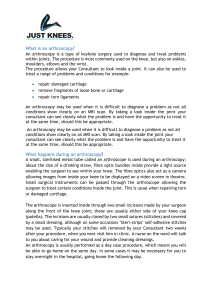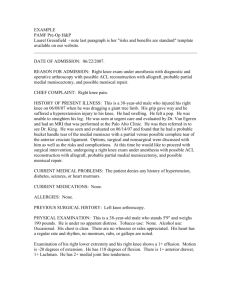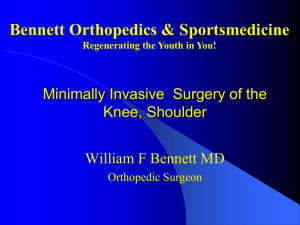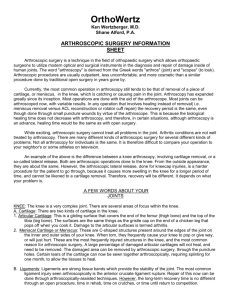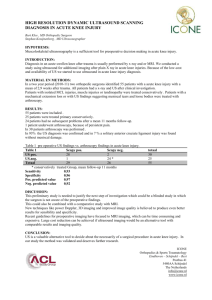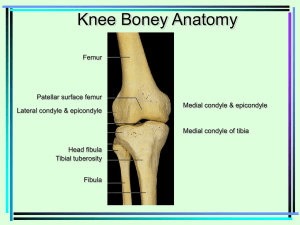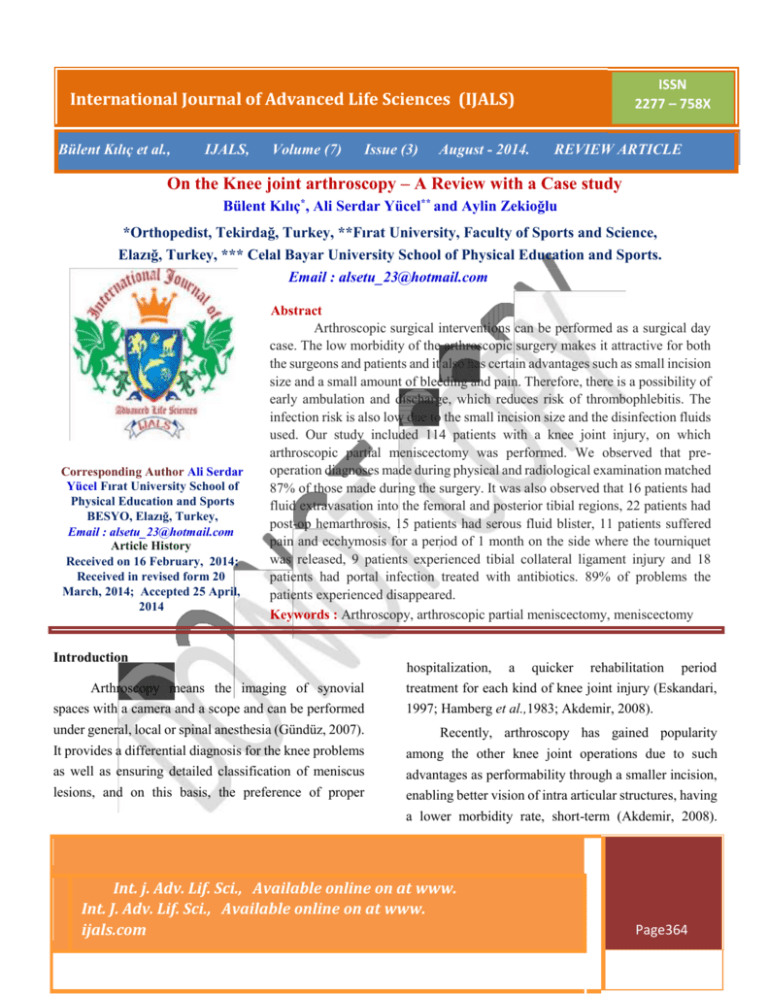
ISSN
2277 – 758X
International Journal of Advanced Life Sciences (IJALS)
Bülent Kılıç et al.,
IJALS,
Volume (7)
Issue (3)
August - 2014.
REVIEW ARTICLE
On the Knee joint arthroscopy – A Review with a Case study
Bülent Kılıç*, Ali Serdar Yücel** and Aylin Zekioğlu
*Orthopedist, Tekirdağ, Turkey, **Fırat University, Faculty of Sports and Science,
Elazığ, Turkey, *** Celal Bayar University School of Physical Education and Sports.
Email : alsetu_23@hotmail.com
Corresponding Author Ali Serdar
Yücel Fırat University School of
Physical Education and Sports
BESYO, Elazığ, Turkey,
Email : alsetu_23@hotmail.com
Article History
Received on 16 February, 2014;
Received in revised form 20
March, 2014; Accepted 25 April,
2014
Abstract
Arthroscopic surgical interventions can be performed as a surgical day
case. The low morbidity of the arthroscopic surgery makes it attractive for both
the surgeons and patients and it also has certain advantages such as small incision
size and a small amount of bleeding and pain. Therefore, there is a possibility of
early ambulation and discharge, which reduces risk of thrombophlebitis. The
infection risk is also low due to the small incision size and the disinfection fluids
used. Our study included 114 patients with a knee joint injury, on which
arthroscopic partial meniscectomy was performed. We observed that preoperation diagnoses made during physical and radiological examination matched
87% of those made during the surgery. It was also observed that 16 patients had
fluid extravasation into the femoral and posterior tibial regions, 22 patients had
post-op hemarthrosis, 15 patients had serous fluid blister, 11 patients suffered
pain and ecchymosis for a period of 1 month on the side where the tourniquet
was released, 9 patients experienced tibial collateral ligament injury and 18
patients had portal infection treated with antibiotics. 89% of problems the
patients experienced disappeared.
Keywords : Arthroscopy, arthroscopic partial meniscectomy, meniscectomy
Introduction
Arthroscopy means the imaging of synovial
hospitalization, a quicker rehabilitation period
treatment for each kind of knee joint injury (Eskandari,
spaces with a camera and a scope and can be performed
under general, local or spinal anesthesia (Gündüz, 2007).
1997; Hamberg et al.,1983; Akdemir, 2008).
It provides a differential diagnosis for the knee problems
among the other knee joint operations due to such
as well as ensuring detailed classification of meniscus
advantages as performability through a smaller incision,
enabling better vision of intra articular structures, having
lesions, and on this basis, the preference of proper
Recently, arthroscopy has gained popularity
a lower morbidity rate, short-term (Akdemir, 2008).
Int. j. Adv. Lif. Sci., Available online on at www.
Int. J. Adv. Lif. Sci., Available online on at www.
ijals.com
Page364
ISSN
2277 – 758X
International Journal of Advanced Life Sciences (IJALS)
Bülent Kılıç et al.,
IJALS,
Volume (7)
Issue (3)
August - 2014.
REVIEW ARTICLE
There is no doubt that arthroscopy provides great
condyle is followed as far as medial compartment and
convenience for orthopaedic surgeons by enabling direct
anteromedial is opened. Medial structures are examined
vision of the intra articular structures. On the other hand,
with the help of a probe. Then the lateral compartment is
failure to provide a vision of extracapsular structures is a
examined. At a knee flexion angle of 70°, intercondylar
disadvantage (Nar, 2008).
notch and anterior-posterior cruciate ligaments are
The joint structures that are treated using
examined. After all the examinations are completed, the
bursa,
operation starts based on the pathological condition. On
suprapateller bursa, plica synovialis suprapatellaris,
the completion of the operation, the joint is irrigated for
cartilaginous patella, patellofemoral joint, femoral
a while, and if needed, a drainage system is set-up and
condyles, tibial plato, medial and lateral meniscus,
the operation is ended (Akdemir, 2008).
anterior and posterior cruciate ligament, lateral inside
Indications of A Knee Joint Arthroscopy
arthroscopy
are
as
follows:
Quadriceps
wall of joint cavity, plica synovialis infrapatellaris,
Arthroscopy has indications such as defining intra
infrapatellar fat pads, synovial villi. The areas that cannot
be reached are inside of the meniscus, outer side of
articular pathology and planning the treatment, removing
specific intra articular pathologies such as meniscus tear,
posterior cruciate ligament (PCL), and popliteal fossa
joint mouse, and osteophytes that cause pain due to
(Barry, 1998 and Ege, 1998). In arthroscopy, anterior
compression, and saving time for the patient with such
cruciate ligament (ACL) is entirely visible. The femoral
insertion of the ACL is observed under the anterior
methods as arthroscopic joint debridement and/or
cruciate ligament. Surrounding the fat pad impairs the
intervention (osteotomy, total or unicondylar knee
visibility of posterior cruciate ligament. In case anterior
arthroplasty, etc.). It is more successful in overcoming
cruciate ligament is torn or ruptured, posterior cruciate
meniscus-tear related symptoms. In case meniscus tests
ligament can easily be used to replace it (Barry, 1998).
In arthroscopy; partial meniscectomy and biopsies can be
are positive in physical examination, arthroscopic
treatment is an appropriate treatment yet not
performed, pathological plica can be relaxed, and
recommended for those with mechanical axis deviation
intraarticular free bodies can be removed without
(Okta,
opening the joint (Gündüz, 2007 and Eskandari, 1997).
Baumgaerterner et al., 1990; Ogilvie-Harris and
In arthroscopy technique, after the scope is placed
through the standard anterolateral portal, the first
abrasion arthroplasty before more serious surgical
2010;
Reddy
and
Gambardella,
2001;
Fitsialos, 1991).
The benefits of arthroscopy are as follows :
suprapatellar cavity is examined while the knee is in the
extended position. Evacuation cannula is placed. Then
scope is rotated 180° in the reverse direction and
patellofemoral joint is assessed. The femur medial
1. Proteinase concentration that is increased due to
arthroscopic irrigation and cartilage degradation
products are removed from the joint and synovial
reaction is reduced (Okta, 2010),
Int. j. Adv. Lif. Sci., Available online on at www.
Int. J. Adv. Lif. Sci., Available online on at www.
ijals.com
Page365
ISSN
2277 – 758X
International Journal of Advanced Life Sciences (IJALS)
Bülent Kılıç et al.,
IJALS,
Volume (7)
Issue (3)
2. Chlorid ions in the irrigation solutions prevent
August - 2014.
REVIEW ARTICLE
8. It is effective in cases where small free bodies or
painful stimulation to pass to unmyelinated C
meniscus parts are needed to be removed.
fibers. This causes a pain relief especially in cases
9. It is used in cases where the disease prognosis is
with knee osteoarthritis (Okta, 2010; Jackson,
needed to be followed (Akdemir, 2008 and Tatari,
1993).
1991),
3. Mechanical symptoms are relieved with the
Contraindications of Knee Joint Arthroscopy
debridement of chondral flap, pathological plica
and degenerative meniscal tears (Okta, 2010),
Surgery is a field of contraindication. In cases
where the movement of the knee joint is highly limited,
The usefulness of arthroscopy can be summed up as
follows :
there is no contraindication and arthroscopy is difficult
1. It enables the diagnosis and treatment of all incidents
that hamper the proper functioning of the joint,
2008).
regular daily activity, and business activities,
to perform due to lack of sufficient maneuver (Nar,
Arthroscopy should be performed only after
studying the complete history, physical examination, and
2. It enables the diagnosis of the knee-joint related
standard non-invasive diagnostic methods. The absolute
cases that could not be diagnosed for various
contraindication of the arthroscopy is the presence of
reasons,
joint sepsis in the local skin infection or the
contamination of surgical field away from an infection
3. In cases where clinical diagnosis is clear, it enables
to
prove
the
diagnosis
before
performing
arthroscopy,
4. It enables early diagnosis and treatment of knee
injuries especially of professional athletes who are
under economic and social pressure,
5. Helpful in medicolegal publications and insurance
focus. Besides, as there is a risk of excessive liquid
extravagation and resulting compartment syndrome in
partial or complete ankylosis of the joint and major
collateral ligamentous and capsular tears, they consist of
relative contraindications (Eskandari, 1997 and Jackson,
1996).
cases, and in cases where the documentation of
In short, the contraindications of the arthroscopy are as
specific lesions,
follows :
6. In the knees with arthritis, it enables to make a final
•
Sepsis or local infection,
diagnosis and identify the necessary treatment
•
Coagulopathy and other systematic diseases,
•
Minimal degenerated knees that can respond to
conservative treatment,
method.
7. In the knees with arthritis, it provides pain relief with
the irrigation of the joint and the disintegration of
minor adhesions.
Int. j. Adv. Lif. Sci., Available online on at www.
Int. J. Adv. Lif. Sci., Available online on at www.
ijals.com
Page366
•
•
physical
The figure (below) of the patellofemoral joint
examination, and standard non-invasive diagnostic
shows that lateral facet is at a close distance to the femur
methods are not applied,
and lies slightly lateral towards the center of
Partial and complete ankylosis: it makes
manipulation impossible; but there are publications
intercondylar channel, and medial facet seems to lie
indicating a usage for lysis of adhesions,
contact with the femur in flexion; but, this relationship
Cases
to
which
complete
history,
•
History of hemarthrosis,
•
Major lateral and capsular tears: because it causes
excessive liquid extravagation (Eskandari, 1997 and
Tatari, 1993).
Arthroscopic Anatomy of Knee Joint
To recognize the lesions in the knee, a systematic
examination is needed during arthroscopy. The listed
order of knee joint arthroscopic examination should be
checked one by one (Nar, 2008). It is more important for
surgeon to follow the same order in every examination
than following the order during the examination
more vertical compared to the lateral. Medial facet is in
cannot be seen through arthroscope (Nar, 2008 and
Tatari, 1993).
When the front face of the arthroscope is rotated to
face superior, quadriceps tendon posterior face can be
seen. The synovium in this area is quite thin. If the
arthroscope is turned to left and right, synovial plicas
trochlear notch (Başaran, 2009) and synovium can be
seen. The villus structure, vascularity, and crystal
accumulations are assessed. Suprapatellar plica is rarely
assessed pathologically (Nar, 2008; Başaran, 2009;
David et al., 2004; Canale and Beaty, 2008).
(Başaran, 2009; David et al., 2004; Canale and Beaty,
2008).
(b) Medial Diverticulum :
The knee joint is divided into 7 compartments during
femoral condyle, medial diverticulum can be seen. Free
knee joint arthroscopy. These are (Başaran, 2009) :
bodies in the medial diverticulum, changes in the
a) Suprapatellar pouch and patellofemoral joint,
b) Medial diverticulum,
c) Intercondylar notch,
When the arthroscope is slided down along medial
synovia, and traumatic capsular damage can be assessed.
(c) Intercondylar notch :
Infrapatellar fat pad, ligamentum mucosum,
d) Medial compartment.
medial and lateral tibial spines, frontal adhesion faces of
both menisci, Humpry and Wrisberg ligaments are
e) Posteromedial compartment,
assessed (Nar, 2008).
f) Lateral compartment,
As the anterior cruciate ligament is relatively in
g) Lateral notch and posterolateral compartment,
front of the posterior cruciate ligament, it is impossible
(a) Suprapatellar pouch and patellofemoral joint :
to see the latter. While most of the anterior cruciate
As the knee is in the extended position, the arthro
ligament and tibial insertion can be seen from the
scopist systematically examines the following structures
anterolateral portal, femoral connection can be better
with the arthroscope in the stretched suprapatellar pouch:
seen from anterolateral portal. The optimum vision angle
Synovia, Synovial plica, Patella, Femur trochlear notch,
Quadriceps tendon (Tatari, 1993).
to observe cruciate ligaments is 45 -90° (Tatari, 1993;
Akdemir, 2008).
Int. j. Adv. Lif. Sci., Available online on at www.
Int. J. Adv. Lif. Sci., Available online on at www.
ijals.com
Page367
ISSN
2277 – 758X
International Journal of Advanced Life Sciences (IJALS)
Bülent Kılıç et al.,
IJALS,
Volume (7)
Issue (3)
In posterior cruciate ligament avulsions, these
synovial plate may bleed and tear. In intercondylar notch,
anterior cruciate ligament (ACL) is the most prevalent
structure. Anterior cruciate ligament together along with
a adhesion face on the tibia is best observed from
anterolateral portal (Başaran, 2009; David et al.,
2004; Canale and Beaty, 2008).
In cases where the synovial sheath is not torn, the
August - 2014.
REVIEW ARTICLE
David et al., 2004; Canale and Beaty, 2008).
(f) Lateral compartment :
After full observation of intercondylar notch,
anterior of lateral compartment is rotated 45° to be
observed. When the knee is positioned with an angle of
80-90°, meniscus posterior and poplitheus tendon are
assessed (Nar, 2008). Lateral compartment of the knee
can be
reached
both through the anterolateral
torn anterior cruciate ligament fibers can be seen by
opening the sheath. The undamaged anterior cruciate
anteromedial portal. If the anterolateral portal is to be
ligament is tight and tense during examination with the
the anterior horn of the lateral meniscus (Başaran, 2009).
probe. When torn, it loses its tightness (Başaran, 2009;
David et al., 2004; Canale and Beaty, 2008).
Lateral meniscus and lateral compartment can be
fully observed from anteromedial portal. If arthroscope
(d) Medial compartment :
is pushed forward towards the fat pad posterior and under
used to see lateral compartment, the portal is right above
Medial compartment is entered by applying valgus
ligamentum mucosum, arthroscopist may encounter
pressure on the knee with a scope of 30°. A probe is
difficult in entering from anteromedial compartment to
placed on anteromedial surface. Medial meniscus and
femoral condyle is palped. The deep medial collateral
the lateral compartment because anterior horn of the
external meniscus has an intercondylar connection
ligament is assessed by removing medial meniscus body.
(Tatari, 1993).
Hemorrhage in this area is assessed as sprain in the
collateral ligament (Nar, 2008).
(g) Lateral diverticulum and posterolateral
compartment :
(e) Posteromedial compartment :
Posteromedial compartment can be monitored
from posteromedial portal or the intercondylar notch
with an oblique scope of 70°. From this point of view,
peripheral part of posterior horn of the medial meniscus,
distal of posterior cruciate ligament, posterior femoral
condyle and free bodies can be seen (Başaran, 2009;
David et al., 2004; Canale and Beaty,
2008). When the compartment is intended to be reached
from posteromedial portal, injector needle can be used to
determine where open a portal (Başaran, 2009;
During
the
posterolateral
compartment
examination, lateral meniscus posterior, poplitheus
tendon, posterolateral synovial and capsular areas, lateral
femoral condyle posterior are observed (Başaran, 2009;
David et al., 2004; Canale and Beaty, 2008). To insert an
arthroscope, anteromedial portal or transpatellar tendon
is frequently used as well as anterolateral portal.
Arthroscope pass through between anterior cruciate
ligament and lateral femoral condyle. If anterior portals
are to be used, an oblique arthroscope of 70° provides a
much better vision (Başaran, 2009; David et al., 2004;
Int. j. Adv. Lif. Sci., Available online on at www.
Int. J. Adv. Lif. Sci., Available online on at www.
ijals.com
Page368
ISSN
2277 – 758X
International Journal of Advanced Life Sciences (IJALS)
Bülent Kılıç et al.,
IJALS,
Volume (7)
Issue (3)
Canale and Beaty, 2008).
August - 2014.
REVIEW ARTICLE
the portal for discharge cannula. However, these portals
Free bodies that cannot be seen when entered
may be used interchangeably by different surgeons
through anterior portals are frequently localized in
(Akdemir, 2008).
posterolateral compartment. In opening posterolateral
portal, the knee should be inflated to the maximum level
Advantages and Disadvantages of Arthroscopy
(a)
Low post-operative morbidity rate: People can go
and have a flexion of 90°. A needle can be used to
back to their work either right away or in 1-2
determine the ideal area for the portal. The portal is
weeks depending on their workload.
localized at the border of biceps femoris tendon anterior
and iliotibial band posterior, and approximately 2 cm
above the posterolateral joint line. In using postero-
(b)
Smaller incision: 2 or 3 incisions of 5 mm will be
enough for arthroscopy.
(c)
lateral portal, oblique scopes of 30° should be used
Less Inflammatory Response: Due to smaller
incision in capsule and synovium, it is less likely
(Başaran, 2009; David et al., 2004; Canale and
to encounter inflammatory response. As a result,
Beaty, 2008).
Arthroscopy Instruments :
patients are less likely to suffer from postoperative
pains, rehabilitation and recovery period is
The imaging system is mainly consists of scopes,
light sources, cameras and monitors. Light source is
relatively shorter.
(d)
High-level of accurate diagnosis: While the rate of
consist of xenon light source and transporting conductive
accuracy is recorded as 70-90% via clinical
fiber optic cable. Surgical instruments: Probe (hooking),
examination, this rate rises to 97% via diagnostic
curettes, electrocautery, cutters (punch), catchers
arthroscopy.
(grasper), motorized tools (shaver, cutter, burr) may be
considered. Washing system: as the wash solution
Lack of secondary effects: Such secondary effects
after arthrotomy as neuroma forming, ugly and
Ringer's lactate, saline, glycine or 5% mannitol is used
painful scars, and potential functional imbalance
(Akdemir, 2008; Bert, 1992) These solutions can be
injected into the joint from a high-level. These solutions
(for example, in the extensor mechanism of the
can be given in the joint by hanging them at a high point
for the aid of gravity or by the pump (arthropump)
(Akdemir, 2008).
are
knee) do not develop after arthroscopy.
(f)
Less hospitalization costs.
(g)
Lower complication rate: Rare complications are
recorded in arthroscopy.
Standard Diagnostic Arthroscopy Portals :
These
(e)
anterolateral,
(h)
It enables follow-up and assessment after
anteromedial,
treatment: After certain procedures (synovectomy
superolateral and superomedial. Anterolateral portal is
or partial meniscectomy, etc.), it is possible to
the portal for scope, and anteromedial portal is the portal
have a second look and make an assessment in the
for surgical instruments. Superolateral or medial portal is
upcoming period.
Int. j. Adv. Lif. Sci., Available online on at www.
Int. J. Adv. Lif. Sci., Available online on at www.
ijals.com
Page369
ISSN
2277 – 758X
International Journal of Advanced Life Sciences (IJALS)
Bülent Kılıç et al.,
(i)
IJALS,
Volume (7)
Issue (3)
August - 2014.
REVIEW ARTICLE
Certain procedures that are difficult to perform
1.
Preventable Complications
with
2.
Potentially Preventable Complications
3.
Unpreventable
arthrotomy
technique
are
easier
in
arthroscopy technique (for example, partial
meniscectomy especially in the posterior and
access to repairable meniscus tears) (Eskandari,
Preventable Complications
1997 and Tatari, 1993).
(a) Neurologic complications
There are only a few disadvantages of arthroscopy;
yet, these disadvantages are of great importance for
arthroscopist. Every arthroscopist may not have the
Complications
(b) Hemarthrosis
(c) Instrument Failure
ability to perform arthroscopic surgery as arthroscopy
(d) Ecchymosis
requires using fragile instruments through very small
(e) Injury recovery complications
portals. That the instruments are required to be
maneuvered within a narrow joint may cause damage to
(f)Potentially Preventable Complications
1. Effusion
the joint surfaces. Also, the instruments required are high
2. Adhesion
in number and cost. One of the disadvantages is that it
requires gaining psychomotor skills to bring two or more
objects together in a certain cavity at one sight. It is
easier to learn the triangulation technique with an
arthroscope of straight (0°) angle. The knowledge of
Unpreventable Complications
1. Infection
2. Cardiovascular complications
familiar structure improved triangulation skill. As a
result of the experience gained in time, surgeon develops
3. Reflex sympathetic dystrophy
During arthroscopy, complications are rarely
encountered, and these complications are minor
(Eskandari, 1997).
a stereoscopic sense and thus, easily bring into the field
a. Major complications
intraarticular anatomy and directing the instrument to a
of vision (Tatari, 1993).
1. Infection
The disadvantages can shortly be listed as
follows:
2. Cardiovascular
1.Instruments are expensive.
2.Joint surfaces may be damaged if the surgeon is
thrombosis, pulmonary emboli)
3. Neurological complications
inexperienced (Eskandari, 1997; Miller, 1992).
4. Hemarthrosis
Complications of Arthroscopy
5. Effusion
6. Adhesions
The complications of arthroscopy can be listed as
follows (Tatari, 1993):
complications (Deep vein
7. Instrument failure
Int. j. Adv. Lif. Sci., Available online on at www.
Int. J. Adv. Lif. Sci., Available online on at www.
ijals.com
Page370
ISSN
2277 – 758X
International Journal of Advanced Life Sciences (IJALS)
Bülent Kılıç et al.,
IJALS,
Volume (7)
Issue (3)
8. Reflex sympathetic dystrophy (Eskandari, 1997;
Tatari, 1993).
b. Minor complications
a. Injury recovery problems
b. Ecchymosis (Eskandari, 1997; Tatari, 1993).
August - 2014.
REVIEW ARTICLE
1. Damage to blood vessels: It is the most critical
complication of arthroscopy. It may be caused by
direct penetration or laceration of vessels, or
sometimes by increase in excessive solution
extravagation related compartment pressure.
rate of hemarthrosis is recorded as high during partial
2. Injury on nerves near joint: Interior branches of
saphena nerve and sartorial branches of femoral
nerve are the most frequently damaged curaneal
nerves.
internal meniscectomy, the rate of instrument failure is
3. Tibial collateral ligament may be damaged by
recorded as high in the partial external meniscectomy
(Eskandari, 1997).
additional medial portals, and it may also be
Interventions with highest rate of complication
are reported as partial internal meniscectomy, partial
external meniscectomy, and chondroplasty. While the
Damage in the intraarticular structures : Corrosion on
damaged by strong valgus pressure applied to open
medial compartment.
joint surfaces: It is probably the most frequent
4. Excessive extravagation of irrigation solution: It is a
complication. Especially when arthroscopist is
inexperienced, the joint is tight and tense, or procedure
very common complication. According to Noyes
is long and difficult; arthroscope or instruments cause
and Spievack, the rupture of suprapatellar cavity is
not rare, and the solution leaking form here can
corrosion on joint cartilage. As a result of this corrosion,
easily move forward towards femoral triangle
progressive chondromalacia changes and degenerative
around superficial femoral anther, dissecting all the
arthritis may develop.
way to that point.
Meniscular and fat pad damage: When the portal is
5. Hemarthrosis: It is the most common post-operative
opened too close to inferior, anterior horns of the
complication, and most commonly observed after
meniscus may be damaged by incision or penetration.
lateral
Also, if the portal is too close to patellar tendon, it may
go beyond fat pad, and due to recurrent penetrations, fat
meniscectomy.
retinacula
release
and
total
lateral
pad may swell and cause hemorrhage, hypertrophy, or
6. Thrombophlebitis: It is potentially the most
dangerous post-operative complication.
fibrosis as well as hampering the vision. Damage to
7. Infection: It is observed quite rarely (under 0, 2%).
cruciate ligaments: Cruciate ligament may be damaged
8. Synovial herniation and fistula: Sometimes fat and
during meniscectomy; and even the undamaged ones
may be damaged in making intracondylar debridement
small particles of synovial tissue may be herniated
during ligament reconstruction (Eskandari, 1997).
Injury on extraarticular structures:
through portals.
9. Instrument failure: It is a rare complication. Edge of
basket (punch) forceps may be broken as they try to
Int. j. Adv. Lif. Sci., Available online on at www.
Int. J. Adv. Lif. Sci., Available online on at www.
ijals.com
Page371
International Journal of Advanced Life Sciences (IJALS)
Bülent Kılıç et al.,
IJALS,
Volume (7)
Issue (3)
August - 2014.
ISSN
2277 – 758X
REVIEW ARTICLE
bite very thick and big meniscus or other tissues.
one leading to the joint surface during arthroscopy, no
Disposable blades of cutting instruments may be
meniscectomy was performed (Fig.- 2). For fibrillations
broken or unlatched (Eskandari, 1997; Miller, 1992;
on meniscectomy surface that cannot be eliminated,
Scott et al., 1993).
resection was performed with arthroscopy device.
Implementation
Intraarticular solution was injected by means of an
We included 114 patients who underwent knee
arthropump. After a thorough irrigation, operation was
arthroscopic partial meniscectomy surgery in our study
terminated. In cases with solution extravagation,
(Figs.- 1, 3, 4). Their average age is 37.6. of the patients
we included; 21 patients suffer from hypertension and 12
suffer from diabetes mellitus. Any additional metabolic
disease was not recorded. The number of female and
drainage was performed by means of percutan injections.
After portal closure and elastic bandaging, tourniquet
was opened. Average surgery duration under tourniquet
is 43 minutes.
male patients is respectively 47 and 67. 46 patients are
We detected that diagnosis based on preoperation
smokers. All the patients referred to us with such
complaints as chronic knee pain, locking, difficulty in
physical examination and radiological tests are
consistent with the diagnosis during the surgery at the
climbing stairs, and knee swelling and stinging. In the
rate of 87%; and it was observed that 16 patients suffered
pre-operation phase, 87 patients were diagnosed with
from liquid extravagation to femoral and posterior tibial
medial meniscus tears at various areas, and 27 patients
were diagnosed with lateral meniscus tears at various
area, 22 patients suffered from postoperative
hemarthrosis, 15 patients suffered from the serous
areas.
accumulation of fluid, 11 patients suffered from pain and
On the completion of necessary pre-operative
preparations, patients were positioned for arthroscopy
under spinal or general anesthesia. The leg to undergo
surgery is bandaged and applied HG pressure of 250 mm
with pneunomatic tourniquet to stop blood circulation.
The patient was prepared in a sterile way. After
ecchymosis lasting up to 1 months in the area where
tourniquet was performed, 9 patients suffered from tibial
collateral ligament damage, and 18 patients suffered
from portal infection that can be healed with antibiotic
treatment. All these complications were healed with
appropriate treatment.
intraarticular imaging by means of scope and camera
89% of these complaints were treated successfully.
through standard anteromedial portal, probe is inserted
Discussion
through anteromedial portal, and all intraarticular tissue
Arthroscopy provides a differential diagnosis for
was examined. Meniscus with the preoperation diagnosis
the knee problems as well as ensuring detailed
was examined, and after the tear was revealed, partial
classification of meniscus lesions, and on this basis, the
meniscectomy was performed. In cases where a tear was
preference of proper treatment for each kind of knee joint
injury (Eskandari ,1997; Hamberg et al., 1983; Akdemir,
diagnosed in pre-operative examination but not detected
Int. j. Adv. Lif. Sci., Available online on at www.
Int. J. Adv. Lif. Sci., Available online on at www.
ijals.com
Page372
2008). In arthroscopy; partial meniscectomy and
biopsies can be performed, pathological plica can be
relaxed, and intraarticular free bodies can be removed
without opening the joint (Eskandari, 1997 and Gündüz,
2007). It is more successful in overcoming meniscus-tear
related symptoms. In case meniscus tests are positive in
physical examination, arthroscopic treatment is an
appropriate treatment yet not recommended for those
with mechanical axis deviation (Okta, 2010; Reddy and
Gambardella, 2001; Baumgaerterner et al., 1990;
Ogilvie-Harris and Fitsialos,1991).
Int. j. Adv. Lif. Sci., Available online on at www.
Int. J. Adv. Lif. Sci., Available online on at www.
ijals.com
Page373
Fig. – 1. : Patient who underwent
arthroscopic partial medial
meniscectomy
Fig. – 2: Patient whom we diagnosed
pre-operative meniscus tear but did
not diagnose pre-operative meniscus
tear leading to joint surface.
Fig. – 3. Patient who underwent
arthroscopic partial medial
meniscectomy
hemorthrosis, ser ous intraarticular accumulation
of
fluid, and tourniquet area pains) were treated without
causing any permanent complications. We also regard
it important in liquid extravagation that arthropump
device worked constantly to stabilize intraarticular
pressure. As we used arthrocare device in surgeries,
there may have occurred intraarticular effusion. We
also found that the stress we applied in cases where we
had difficulty in observing posterior of medial
compartment caused tibial collateral to release. We
observed hemarthrosis occurrence in some medial
partial meniscectomy cases (Eskandari, 1997).
Fig. - 4. Patient who underwent
114 surgeries
patients inare
ourmost
study
were only diagnosed with
Arthroscopic
commonly
arthroscopic partial medial meniscectomy
applied in meniscus pathologies.
thisSci.,
study,Available
we
Int. j. Adv.InLif.
online on at www.
recorded a 89%
success
with
arthroscopic
surgery
we
Int. J. Adv. Lif. Sci., Available online on at www.
applied for meniscus
problems in 2 week time.
ijals.com
The fact that this study included partial
meniscectomy operations excluding cases only requiring
Page374
ISSN
2277 – 758X
International Journal of Advanced Life Sciences (IJALS)
Bülent Kılıç et al.,
IJALS,
Volume (7)
Issue (3)
August - 2014.
REVIEW ARTICLE
ISSN
2277 – 758X
International Journal of Advanced Life Sciences (IJALS)
Bülent Kılıç et al.,
IJALS,
Volume (7)
Issue (3)
August - 2014.
REVIEW ARTICLE
meniscus tear without suffering from mechanical axis
patients suffered from (liquid extravagation, study did
deviation (Fig.-1- 4). We could not detect any relation
not include patients of older ages, and among the factors
between meniscus tears and joint in the patients with
affecting recovery potential, only patients with a
meniscus tear diagnosis based on pre-operative
smoking problem were included.
examination and radiologic tests. Yet, we observed that
Conclusion
pre-operation
and
Arthroscopy provides a differential diagnosis for
radiological examination matched 87% of those made
the knee problems. It facilitates a detailed classification
during the surgery. It is significant that complications the
of knee joint problems and the preference
of the appropriate treatment method. Arthroscopy should
only be performed after complete history, physical
antibiotic treatment. All these complications were healed
with appropriate treatment.
examination, and standard non-invasive diagnostic
89% of these complaints were treated successfully.
methods.
Acknowledgement
The
diagnoses
absolute
based
on
physical
contraindication
of
the
arthroscopy is the presence of joint sepsis in the local
skin infection or the contamination of surgical field away
from an infection focus.
In this study, we detected that diagnosis based on
pre-operation physical examination and radiological
tests are consistent with the diagnosis during the surgery
at the rate of 87%; and it was observed that 16 patients
suffered from liquid extravagation to the femoral and
posterior tibial area, 22 patients suffered from postoperative hemarthrosis, 15 patients suffered from the
serous accumulation of fluid, 11 patients suffered from
pain and ecchymosis lasting up to 1 months in the area
where tourniquet was performed, 9 patients suffered
from tibial collateral ligament damage, and 18 patients
suffered from portal infection that can be healed with
The authors Ali Serdar Yücel and Aylin Zekioğlu
gave support in the translation and summarization of the
source used in the research in addition to literature
support. References
Akdemir, M. 2008. Dizin Eklem İçi Patolojilerinin
Tanısında Fizik Muayene Ve Manyetik Rezonans
Yöntemlerinin Karşılaştırılması, Dissertation,
T.R. Dokuz Eylül University Faculty of Medicine,
Department of Orthopaedics and Traumatology,
İzmir.
Barry, B. 1998. Arthroscopy of Lower Extremity. In:
Canale,
S.T.
(Eds).
Campbell's
Operative
Orthopaedics. Missouri: Mosby-Year Book. pp.
1479 - 1485.
Int. j. Adv. Lif. Sci., Available online on at www.
Int. J. Adv. Lif. Sci., Available online on at www.
ijals.com
Page375
ISSN
2277 – 758X
International Journal of Advanced Life Sciences (IJALS)
Bülent Kılıç et al.,
IJALS,
Volume (7)
Issue (3)
August - 2014.
REVIEW ARTICLE
Başaran, T. 2009. Elektrokoter Ve Makas İle Yapılan
Lateral Gevşetmenin Süresi Ve Kanama
Miktarları Arasındaki Fark, Dissertation, T.R.
Hacettepe
Değerlendirilmesinde Fleksiyon Çekimlerinin
Tanıya Katkısı, Dissertation, T.R. Yüzüncü Yıl
University Faculty of Medicine, Department of
Hamberg, P., Gillquist, J. and Lysholm, J. 1983. Suture
University Faculty of Medicine, Department of
Radiology,Van.
Orthopaedics and Traumatology, Ankara.
of New and Old Peripheral Meniscus Tears. J.
Baumgaerterner, M.R., Connon, W.D, Vittori, J.M,
1990.
Bone Joint Surg., 65(2) : 193 - 7.
Jackson, R.W. 1991. Arthroscopic treatment of
Artrhroscopic debridement of the arthritic knee.
degenerative arthritis. In: McGinty (ed), Operative
Clin. Orthop, 253 : 197 - 202.
Arthroscopy, Rawen pres, New York. pp.319-23.
Schmidt,
E.S.
and
Maurer,
R.C.
Bert, J.M. 1992. Use of an electrocautery loop probe for
Jackson, R.W. 1996. The Painful Knee; Arthro scopy or
arthroscopic meniscectomy: a five year experience
MR Imaging? J. Am. Acad. Orthop. Surg., 2: 93-9.
with results, indications, and complications.
Miller, R.H. 1992. III: Arthroscopy of lower extremity.
Arthroscopy., 8(2): 148 - 56.
Canale, T.S.
In: Crenshaw AH(ed). Campbell's Operative
and Beaty, J.H. 2008. Campbell's
Operative Orthopaedics, Phillips, Barry, B (Eds.)
Arthroscopy of lower extremity. Campbell’s
Orthopaedics. St Louis, Mosby Year Book. (8) :
1787 - 864.
Nar, Ö.O. 2008. Dizin Eklem İçi Patolojilerinin
operative Orthopaedics., 3 : 2515 - 2612.
Tanısında Klinik Muayene, Manyetik Rezonans
Görüntüleme Ve Artroskopi Bulgularının
David, H., Kim, M.D, Thomas, J, Gill, M.D. and Peter,
J. and Millett, M.D. 2004. M.Sc. Arthroscopic
Treatment
of
the
Arthrofibrotic
Knee
Arthroscopy: The Journal of Arthroscopic and
Karşılaştırılması,
Dissertation,
T.R.
Kahramanmaraş Sütçü İmam University Faculty
of Medicine,
Related Surgery., 20 (6): 187 - 194.
Department of Orthopaedics and Traumatology,
Kahramanmaraş.
Ege, R. 1998. Diz Anatomisi, in: Ege, R, Ed. Diz
Sorunları. Ankara: Bizim Büro Basımevi. pp.
Ogilvie-Harris,
812 - 824.
Çukurova University Faculty of Medicine, Depart
ment of Orthopaedics and Traumatology, Adana.
Gündüz, A.M. 2007. Menisküs Yırtıklarının Mrg İle
and
Fitsialos,
D.P.
1991.
Arthroscopic management of degeneratif knee.
Eskandari, M.M. 1997. İzole Meniskus Yırtıklarında
Artroskopik Menisektomi, Dissertation, T.R.
D.J.
Arthroscopy., 7(2) : 151 - 7.
Okta,
C. 2010. Diz Osteoartritinin Tedavisinde
Artroskopik Debridmanın Yeri: Hayat Kalitesi
Temelinde Hasta Seçimine Yardımcı Olacak
Parametrelerin Araştırılması, Dissertation, T.R.
Int. j. Adv. Lif. Sci., Available online on at www.
Int. J. Adv. Lif. Sci., Available online on at www.
ijals.com
Page376
Celal Bayar University Faculty of Medicine,
Anatomy and Techniques. In: Insall JN(ed).
Department of Orthopaedics and Traumatology,
Surgery of The Knee, New York, Churchill
Manisa.
Livingstone, (2) : 165- 215.
treatment of degeneratif joint disease of the knee.
Tatari, H. 1993. Menisküs Yaralanmalarının Tanısında
Bilgisayarlı Tomografi Ve Manyetik Rezonans
Techniques in Knee Surgery. Harner CD, Vince
KG, Fu FH (eds), Lippincott, Williams and
Görüntüleme
Yöntemlerinin
Artroskopik
Bulgularla Karşılaştırılması, T.R. Dokuz Eylül
Wilkins. pp. 159 - 64.
University
Reddy, A.S. and Gambardella, R.A. 2001. Arthroscopic
Scott, W.N., Insall, J.N. and Kelly, M.A. 1993.
Arthroscopy and Meniscectomy; Approaches,
Faculty of Medicine, Department of Orthopaedics
and Traumatology, Dissertation, İzmir.
Corresponding Author : Ali Serdar Yücel, Fırat University School of Physical Education and Sports BESYO, Elazığ, Turkey,
Email : alsetu_23@hotmail.com, © 2014, IJALS. All Rights Reserved.
Int. j. Adv. Lif. Sci., Available online on at www.
Int. J. Adv. Lif. Sci., Available online on at www.
ijals.com
Page377


